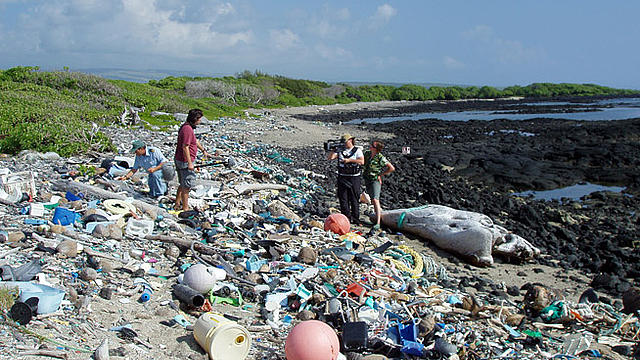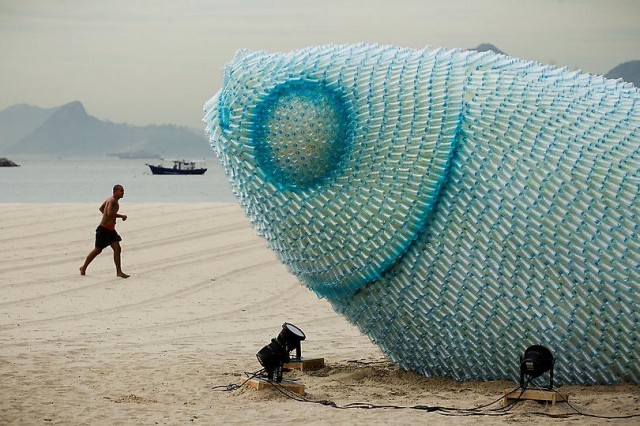Category Archives: plastic debris
As the Oceans Choke on Plastic so do the Whales
This whale had swallowed 59 different plastic items totaling over 37 pounds. Most of this plastic consisted of transparent sheeting used to build greenhouses in Almeria and Grenada for the purpose of tomatoes for the European market. The rest was plastic bags, nine meters of rope, two stretches of hosepipe, two small flower pots, and a plastic spray canister. Cause of death was intestinal blockage.
Getting at the Source (at least one or two)
I’ve been concerned about ocean debris since 2006 when I first started to write about it. Public awareness of this issue is growing and I’ve been able to follow Charles Moore, the Plastiki and various other efforts to explore and mitigate this issue. Most efforts have simply underscored how intractable the problem is and how it is only getting worse.
Well I’ve been tipped off that there are a number of other minds at work on this issue and I am happy to showcase two of them today. Banning plastic bags in California was a biggie; it may be that these two programs that hit at the source of the problem may be very big in their own right.
Cleaning the Oceans?
One very enterprising young man has taken on a planet-sized project!
“Confounded by the detritus of civilization”
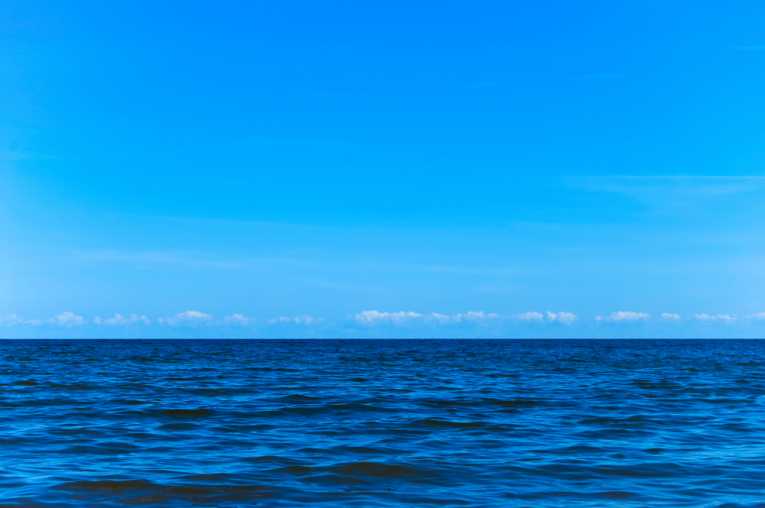 Just imagine this weeks-long search for the missing Malaysian airliner across thousands of miles of ocean. Just the blue sky and the blue water as far as the eye can see.
Just imagine this weeks-long search for the missing Malaysian airliner across thousands of miles of ocean. Just the blue sky and the blue water as far as the eye can see.
Now the reality. It appears that the search for a broken up 777 airliner, nearly the size of a football field, is hard to pick out of the vastness of this space because there is so much other trash out there!.
There is something very profound in this statement, “confounded by the detritus of civilization”, made by the same Charles Moore I’ve written about before (here and here.) He has seen what he speaks about; he has visited known trash areas year after year as part of his research. He has focused generally on the amount of plastic that has been inadvertently washed out to sea from city gutters and beaches. Since this never breaks down into organic matter but rather biodegrades into smaller particles there is now evidence that this plastic is moving through the oceanic food chain from fish and turtles to birds.
The trash is more extensive than we can really grasp. This floating plastic breaks down into micropellets that float just beneath the surface and gets swooped up by fish and birds as the bits of color surface and sink again. A large oceanic region called the “Pacific Gyre” or the “Great Pacific Garbage Patch” where moving currents have brought plastic into areas the size of Texas now seems the least of our worries. According to the New York Times, there are as many items of trash in our oceans as you can bring yourself to imagine–mattresses, broken up ships, fishing nets, shipping containers–up to 700 per year!–not to mention the estimated 5 million tons of debris that swept into the Pacific following the 2011 tsunami in Japan.
I remember a long time ago when the “Keep America Beautiful” campaign would show up on trash cans and billboards and even be advertised on the few channels we had on television. Everyone became aware of trash on our streets, trash cans popped up on every street corner and god forbid if you were caught throwing something out of a car window. This program has taken on new life in many forms but the ethos of it always remains the same–we have to stop dirtying where we live.
We need a Make Our Oceans Beautiful campaign. No more excuses. “Out of sight, out of mind” just doesn’t cut it anymore, because now, without a doubt, we know what is out there.
RIO+20
These beautiful pieces of art were assembled on the beach out of recycled water bottles. See more here. While the conference on sustainable development was largely labeled a failure because little to no progress was made on critical issues, this expressive installation will be a startling reminder of the unconscionable waste that continues–at least until the sun degrades it into a gadzillion minute particles that will wash out to sea and join the Pacific Gyre.
Our Plastic Period–Charles Moore and the Alguita
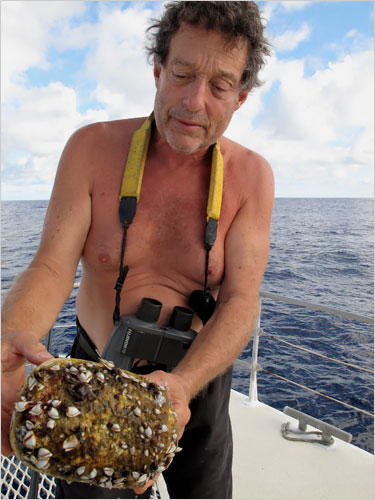
Charles Moore is on his 10th trip to visit the Pacific Gyre–the spot in the Pacific Ocean that holds a growing island of plastic trash caught in its currents, previously written about in this blog here and here. A good article today in the New York Times explains what Mr. Moore has been doing since his first trip in 1997, when he accidentally stumbled upon this phenomenon. His work and that of others has inspired some of the rich and famous to get involved, namely Ted Danson with his Oceana project and David de Rothschild, whose brainchild the Plastiki Expedition he created when he read a 2006 UN report on trash in the oceans.
The issue of plastic in the oceans seems to be growing in the public awareness, although can any of us say that something has really changed? When one thinks about the enormous usage of plastic, not only here, but throughout the developing world, it is difficult to see a solution to what may be an insurmountable problem. The plastic doesn’t just float and somewhat degrade into smaller and smaller bits, it is ingested by sea creatures and travels up the foodchain. It is also becoming evident that our casual and regular use of plastic in water bottles and food packaging may be having an insidious effect on us as chemicals leach into our bodies. Nicholas Kristof of the New York Times says tellingly that he has confronted extreme African poverty and disease, as well as dangerous warlords but is frankly terrified of the growing amount of bisphenol A or BPA accumulating in his tissues.
One day we may look back on our Plastic Period like boomers on the days of thalidomide babies. While I am not advocating that we all go the way of “No Impact Man” , I am heartened that there is some serious research being done to study the causes and effects of what may become known as our “Plastic Period.”
Soupe de Plastique
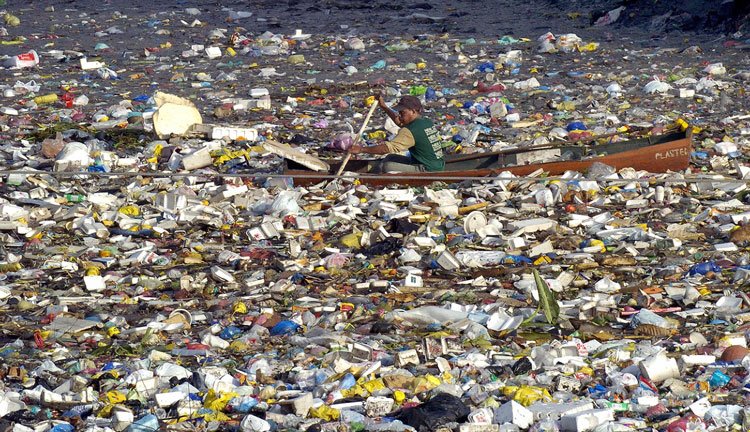
Imagine yourself independently wealthy. You buy yourself a yacht. You love the open seas. You become passionate about sailing and your life revolves around planning trips to exotic places.
Then something happens that changes your world.
Such is the story of Charles Moore, heir to an oil fortune, now environmental activist and founder of the Algalita Marine Research Foundation.
After designing his own unique racing yacht, Moore entered a Los Angeles to Hawaii race. It was 1997. Upon sailing home he willfully entered a part of the Pacific Ocean as a shortcut home, an area that is usually avoided by sailors and fishermen: an area of weak winds and weak currents and little fish that is the eye of a circle of currents thousands of miles wide called the North Pacific Gyre.
What he stumbled upon changed his life.
A sea–as far as the eye could see–of plastic debris–yellow Chevron oil bottles, tampon applicators, plastic bags, old fishing lines, shampoo bottles and Japanese traffic cones. He traveled for days through discarded plastics, miles after mile after mile.
I can only imagine his disbelief, his shock. When I first read about his experience, I too was shocked and wrote about it here. The ocean that he sailed because it was endless and pristine, was much like the wilderness that avid backpackers venture into to escape civilization –only to find the its ugliest remnants–trash.
In Moore’s words:
I often struggle to find words that will communicate the vastness of the Pacific Ocean to people who have never been to sea. Day after day, Alguita was the only vehicle on a highway without landmarks, stretching from horizon to horizon. Yet as I gazed from the deck at the surface of what ought to have been a pristine ocean, I was confronted, as far as the eye could see, with the sight of plastic.
Not a scientist himself, but with conviction and money, Moore founded the Algalita Marine Research Foundation in 1999 and built a network of chemists and scientists. He enjoined Curtis Ebbesmeyer, an oceanographer and leading authority on flotsam, who famously tracked the spill of 80,000 Nike running shoes on their way from China to the US. (the resultant wash-up on beaches throughout the Pacific allowed him to track and identify the behavior of currents).
Since this initial discovery and the funding of the Foundation, Moore has underwritten several trips to the area for further research. In 2001, according to the Marine Pollution Bulletin, they published that there were six pounds of plastic floating in the North Pacific subtropical gyre for every pound of naturally occurring zooplankton.
Most recently, after another exploration and research trip to the region, Moore acknowledges that the results are beyond imagination: the plastic soup he encounters is now–not the size of Texas as was noted in 1997. Not the size of the United States as noted in 2001. Now it is estimated, when one takes into account the “eastern” and “western” patches, to be double the size of the continental US.”
There are those who dispute his figures and Moore acknowledges that it is difficult to document the phenomenon. Satellite imagery is not able to pick up the plastic because it floats slightly below the surface and is largely translucent.
The “soup” is actually two linked areas, either side of the islands of Hawaii, known as the Western and Eastern Pacific Garbage Patches. According to a study released by Greenpeace, about one-fifth of the junk – which includes everything from footballs and kayaks to Lego blocks and carrier bags – is thrown off ships or oil platforms. The rest comes from land.
Ebbesmeyer, as “flotsam expert” portrays the North Pacific plastic trash cluster vortex as a living entity:
“It moves around like a big animal without a leash.” When that animal comes close to land, as it does at the Hawaiian archipelago, the results are dramatic. “The garbage patch barfs, and you get a beach covered with this confetti of plastic,” he added.
All this plastic breaks down but never goes away. Sunlight breaks the plastic into smaller and smaller bits, all ingested gradually into the food chain. Birds dive for the brightly colored plastic and sea turtles chase plastic bags like jellyfish.
“What goes into the ocean goes into these animals and onto your dinner plate. It’s that simple,” said Dr Marcus Eriksen, director of research and education.
This is our petroleum, our drilled and pumped oil, our endless ingenuity, reconfigured into new matter; matter causing serious consequences for our living on the planet.
The annual production of plastic resin in the United States has roughly doubled in the past 20 years, from nearly 60 billion pounds in 1987 to an estimated 120 billion pounds in 2007, according to a study by the American Chemistry Council, which represents the nation’s largest plastic and chemical manufacturers.
So plastic is not going to go away. We can’t even do a massive cleanup operation to stop the damage. But we must start being aware of what we are doing. Remember that lovely video of the floating plastic bag in the movie “American Beauty”? Now picture that bag escaping the little whirlwind it was in as it begins its journey down the storm drain and out to sea.
“Oil is the raw material for most plastics manufacturing; oil was also the source of Moore’s inherited fortune.
“In a way, part of all this is remediation for the consequences of my grandfather’s life,” Moore says. “I guess maybe I need to make amends.”
The Larger Issue of Our Watery World
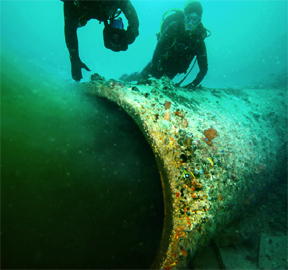
My earlier postings about plastics in the ocean have had family and friends alike question the extent to which this condition is real or am I just exaggerating. A plastic-filled area of the Pacific Ocean the size of the United States? That’s ridiculous! Nobody would let that happen. The oceans get some junk dropped into them now and again but…come on, now.
As individuals, and I include myself, we are simply unconscious of so many things.
Education transforms however, and without hubris I embrace this state of awakening that is the result of my studying these issues. I remember graduate school as a peeling away of layers of obscurity, reaching into the complexities of politics and international relations. There was an exhilaration in that newfound knowledge.
Today, my self-education brings a sense of awe, acute awareness and a heavy feeling of responsibility.
But back to our watery world. For the skeptics or for the interested, please visit this well-done special multimedia series on the declining health of our oceans. This award-winning piece, a 5-part series called “Altered Oceans”, was put together by Kenneth Weiss and Usha Lee McFarling of the Los Angeles Times. Just today the Metcalf Institute announced that the pair had won a $75,000 Grantham Prize for Excellence in Reporting on the Environment. The jurors claimed that the authors of the series:
“did more than simply research the literature and talk to the best minds. They went to the scene to make the case. This extraordinary series gives life to all those generalities about the decline of the oceans in a way that should grab the imaginations not only of politicians responsible for taking corrective steps
but also of ordinary readers.”
The format is powerful. The combination of video interviews, stunning photographs and informative charts and graphs works to reveal the complexities of the profound changes taking place just out of our view.
Let the education begin.
Water on My Mind (Update I)
Charles Moore, the marine debris expert with the Algalita Marine Research Foundation, and the gentleman interviewed in the film excerpts available on www.messageinthewaves.com has produced updated findings on this “island” of plastics in the ocean. The North Pacific Gyre, an area northwest of Hawaii where two currents meet originally was composed of an eastern and a western lobe of plastic debris. It appears that the two lobes have merged into a 5 million square mile area, the size, not just of Texas, but of the entire United States.
Why isn’t this front page news?


